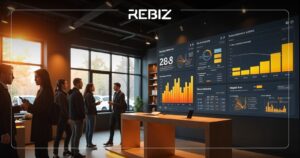Nowadays, wireless retail operators must transcend beyond offering an impressive product lineup and exceptional customer service to achieve profitability and maintain a competitive edge. To truly thrive, wireless retailers must harness data-driven insights to inform their business and operational decisions.
Let us delve into the 10 crucial retail store performance metrics that every wireless retailer in the United States should meticulously track to secure business success.
By closely monitoring these store retailer monitoring metrics, wireless retailers will be better equipped to optimize operations, enhance customer experience, and ultimately boost their profitability.
1. Store Opening & Closing Hours
What Is It :
Opening and closing hours denote the periods when a wireless retail store commences and concludes its daily operations. This encompasses retailer monitoring of both the scheduled hours and the actual hours during which the store opens and closes each day.
Why is Store Timing Important:
Real time monitoring of store opening and closing time tracking can help identify the peak hours of customer traffic & sales, enabling retail store metrics optimization of store hours as well as staffing. Moreover, ensuring consistency of store hours helps build customer loyalty & experience.
How it Can Be Leveraged & Improved :
- A crucial aspect to monitor and improve is employee compliance with scheduled opening and closing times. This includes flagging instances of late openings and early closings.
- Track peak hours throughout the day or specific times of the year to optimize store hours, staffing, and inventory management.
- Utilize a tracker that collects accurate data. This will provide insights into opening and closing hours and correlate them with your store’s performance.
2. Foot Traffic
What Is It :
Foot traffic measures the number of people entering your store, providing essential insight into customer engagement and store performance.
Why Is Foot Traffic Important:
Foot traffic is a vital metric for gauging how effectively your store attracts potential customers, highlighting the success of your marketing efforts and the appeal of your location. Measuring total and customer-only foot traffic is essential to understanding overall activity and authentic selling opportunities each day comprehensively. Employing a footfall counter can help identify the days, weeks, events, or seasons that draw higher foot traffic. The Footfall Counter by Rebiz provides an ideal solution for accurately and effectively measuring this critical metric.
How Can It Be Improved:
- Launch targeted marketing campaigns to drive increased store traffic.
- Host in-store events and promotions to attract more store traffic and leverage idle time outreach programs to maximize engagement.
3. Retail Conversion Rate
What Is It :
Retail conversion rate is the percentage of store visitors who purchase.
Why is Retail Conversion Rate Critical:
Tracking conversion rates at the rep level allows retailers to identify top-performing employees and those who may need additional support. This data is invaluable for understanding how each sales rep contributes to overall sales performance. Regularly measuring individual conversion rates empowers store managers to tailor coaching, refine sales techniques, and ultimately drive improvements in rep-level performance. Reps with higher conversion rates can serve as models, while those with lower rates can receive targeted training.
How Can It Be Improved:
- Strengthen the skills of your sales team by providing personalized coaching based on their individual conversion rates.
- Encourage a competitive and results-driven atmosphere by publicly sharing rep-level conversion metrics, motivating employees to improve their performance.
- Deliver an exceptional in-store experience that enhances conversion opportunities by aligning top-performing reps with peak traffic hours.
- Use insights from the data to optimize staffing levels and align reps with the times they perform best, maximizing sales potential.
4. Sales Volume
What Is It :
Sales volume encompasses the overall quantity or amount of goods or services a store sells within a defined timeframe, be it a month, quarter, or year. It represents the aggregate revenue generated from the company’s sales endeavors during that period, irrespective of the pricing of individual items or services.
Why is Sales Volume Essential:
Sales volume is a key indicator of your marketing and operational effectiveness, helping track retail store metrics. High sales volumes suggest successful marketing campaigns and efficient store operations.
How Can It Be Improved:
- Implement targeted promotions and discounts to increase sales.
- Offer a diverse and appealing range of products or services that align with customer expectations and preferences.
- Invest in impactful marketing strategies to draw more customers to your store.
5. Average Revenue Per Visit (ARPV)
What Is It:
ARPV, or Average Revenue Per Visit, is calculated by dividing the total revenue generated within a specific period by the number of visits or transactions during that time frame. This metric shows how much revenue, on average, each visit to your store or business contributes.
Why Is ARPV Important:
ARPU is a crucial retail store performance metric for retailer monitoring, as it is an immediate indicator of your business’s operational performance and profitability. By maximizing ARPU, you ensure that each customer contributes more to your business revenue, which is critical in an industry where customer acquisition costs are high.
How Can It Be Improved:
- Offer additional or complementary products or services to increase the overall transaction value during each visit.
- Create attractive product or service bundles that encourage customers to spend more per visit.
- Introduce loyalty or reward programs that incentivize repeat visits and higher spending per visit.
- Improve the in-store or online experience, making it more personalized to encourage customers to stay longer and spend more.
- Offer personalized discounts based on previous purchase behavior to entice customers to make higher-value purchases on future visits.
6. Inventory Turnover Ratio
What Is It :
This ratio determines the speed at which inventory is sold and replenished within a specified timeframe.
Why Is The Inventory Turnover Ratio Important:
A high inventory turnover ratio signifies effective sales and inventory management, diminishing holding costs and mitigating the risk of obsolescence.
How Can It Be Improved:
- Utilize sales data to accurately predict demand and adjust inventory levels accordingly.
- Maintain optimal inventory levels to ensure products are available without overstocking or shortages.
- Implement strategic promotions to facilitate the movement of slow-moving inventory.
7. Sell-Through Rate (STR)

What Is It :
The sell-through rate is the percentage of inventory sold within a designated timeframe. Calculated by dividing the number of units sold by the initial inventory and then multiplying by 100, this metric provides insights into inventory management and sales performance.
Why is STR Important:
This metric aids in evaluating the effectiveness of inventory management and sales performance, revealing how efficiently products are being sold compared to their availability. A high STR signifies proficient inventory management and robust sales performance, whereas a low STR indicates overstocking and elevated holding costs.
How Can It Be Leveraged & Improved:
- Implement time-sensitive promotions to stimulate sales of slow-moving items.
- Continuously review and adjust stock levels according to sales data.
- Strategically position high-demand products to optimize visibility and sales opportunities.
8. Out-of-Stock Rate (OSR)
What Is It :
OSR, or “On-Shelf Availability Rate,” is a crucial metric in retail operations. It measures the time a product remains on the shelf for customers to purchase. OSR is calculated by dividing the number of out-of-stock items by the total SKUs and multiplying by 100.
Why is OSR Important:
OSR offers insights into the efficacy of inventory management, supply chain operations, and store execution in maintaining consistent product availability. A low OSR signifies adept inventory planning, guaranteeing that sought-after products are consistently in stock, enhancing customer satisfaction, and driving sales.
How Can It Be Improved:
- Employ real-time inventory monitoring systems to track stock levels accurately.
- Implement automated replenishment systems to minimize occurrences of stockouts.
- Foster close collaboration with suppliers to ensure timely restocking of fast-moving items.
9. Sales Per Employee (SPE)
What Is It :
Sales per employee (SPE) is a metric used to assess the productivity and efficiency of a company’s workforce in revenue generation. It quantifies the average sales generated by each employee, providing insights into workforce effectiveness and contribution to revenue generation.
Why is SPE Important:
This metric aids in evaluating the effectiveness of employee performance and the optimal utilization of resources in fostering sales and revenue growth. A high SPE signifies efficient and effective staff performance, significantly contributing to overall store sales.
How Can It Be Leveraged & Improved:
- Invest in resources to provide regular training sessions to enhance sales techniques and deepen product knowledge among employees.
- Implement performance-based incentives to inspire employees to elevate their sales efforts and results.
- Strategically adjust staffing levels to guarantee that each employee can effectively serve customers, optimizing the shopping experience.
10. Customer Feedback (Customer Experience)

What Is It :
Customer experience as a retail metric encapsulates customers’ holistic impression and satisfaction level during their interactions and transactions within a store. This comprehensive metric encompasses ease of navigation, product availability, service quality, staff friendliness, checkout experience, and overall ambiance.
Why is Customer Experience Necessary:
Tracking customer experience is vital for retailers to enhance overall customer satisfaction. This leads to heightened loyalty, increased sales, and positive word-of-mouth referrals, which are crucial for the success of wireless retailers. Retailers can use surveys, mystery shopping, social media monitoring, CRM systems, and in-store observations to gather insights and improve satisfaction.
How Can It Be Improved:
- Provide comprehensive staff training to ensure excellent service and in-depth product knowledge.
- Act promptly on customer feedback to address areas requiring improvement and enhance satisfaction.
- Implement technology solutions and loyalty programs to enrich the shopping experience and foster customer loyalty.
Optimize Decision-Making For Your Wireless Retail Business
In the wireless retail sector, harnessing and optimizing these ten pivotal retail store performance metrics offers the insights necessary to make well-informed decisions and propel business triumph. By prioritizing metrics like sales conversion rates, customer retention, average transaction value, inventory turnover, and foot traffic, retailers can cultivate a streamlined, customer-centric operation that distinguishes itself in the market.
Integrate these metrics into your strategic planning and operational review processes to elevate your bottom line and cultivate a devoted customer base that drives sustained growth and prosperity.
Embrace these metrics as part of your strategic planning. Tracking retail sales metrics and retail performance data offers a competitive edge, enabling data-driven decisions that foster long-term growth and customer loyalty.



